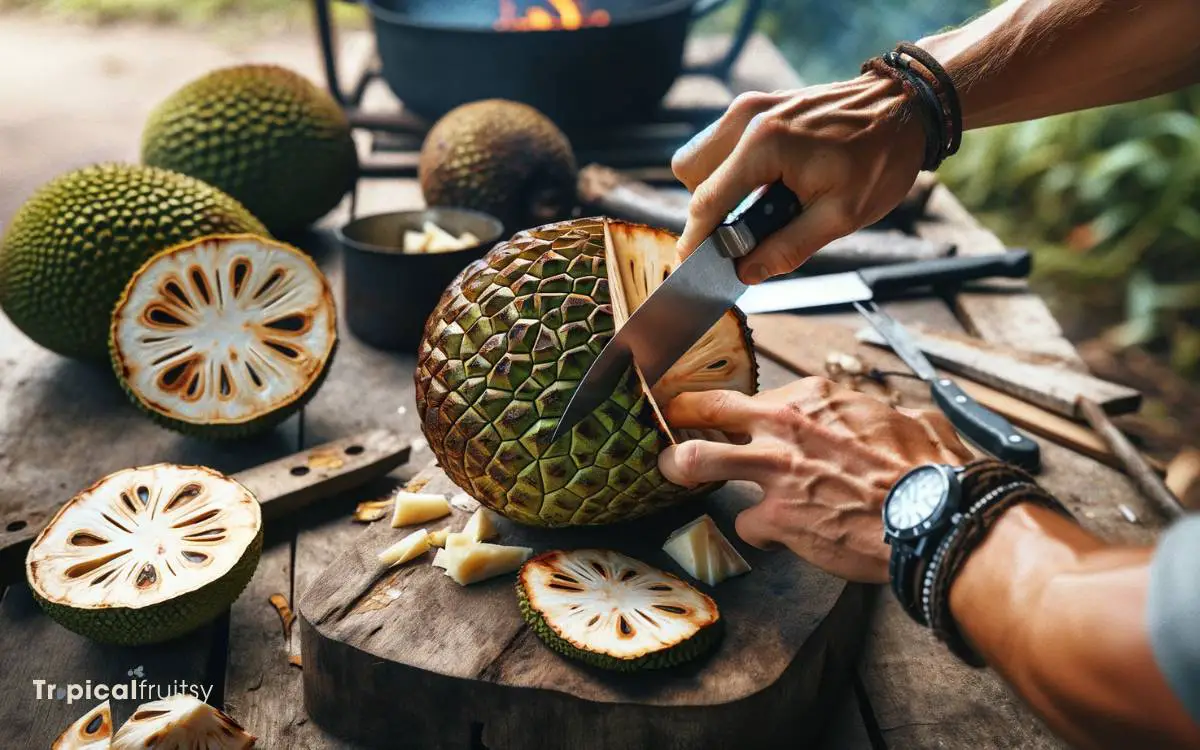How to Roast Breadfruit on an Open Fire? 6 Easy Steps!
Roasting breadfruit on an open fire is an art that brings out its natural flavors with a smoky twist.
To achieve the perfect roast, select a ripe breadfruit, initiate a steady fire, and use the right tools. Begin by scoring the skin, then apply oil to the fruit.
Employ a methodical roasting technique, rotating the breadfruit for uniform cooking. The fruit is done when it’s soft inside and charred outside. Serve this roasted treat as a savory or sweet dish to delight in its unique taste.
The process of roasting breadfruit over an open fire involves several key steps:
Discover the robust flavors of roasted breadfruit, a tropical delight transformed by the kiss of open flames.

Key Takeaway
Gathering Necessary Tools
To successfully roast breadfruit on an open fire, three essential tools are required: a sturdy pair of tongs, a wire grill, and a source of fire such as wood or charcoal.
Each tool plays a pivotal role in the roasting process, ensuring the breadfruit is cooked evenly and safely.
- Sturdy Tongs: These will be used to carefully turn the breadfruit, allowing for an even roast on all sides without risking burns.
- Wire Grill: A robust wire grill is necessary to hold the breadfruit over the flames, providing consistent heat distribution.
- Fire Source: Wood or charcoal must be readily available to maintain a steady fire, generating the required embers for optimal roasting.
Equipped with these tools, it’s time to turn our attention to properly prepping the breadfruit for roasting.
Step 1: Selecting the Perfect Breadfruit

Before roasting breadfruit on an open fire, one must ensure to select a fruit that is firm to the touch and has a greenish-yellow skin, indicating optimal ripeness for roasting.
This stage of maturity is crucial as it contributes to the final texture and taste. The surface should be blemish-free, and the stem slightly soft, suggesting that the fruit is ready to be cooked.
The ideal breadfruit emits a faint, sweet fragrance. It’s important to note that breadfruit continues to ripen after being picked, hence choosing one at just the right stage ensures a delicious yield.
Gently press the skin – it should yield slightly under pressure, akin to a ripe avocado. With the perfect breadfruit selected, the next critical step is preparing your fire for roasting.
Step 2: Preparing Your Fire

Preparing an optimal fire for roasting breadfruit begins with the judicious selection of firewood. Hardwoods such as oak or hickory are preferred for their ability to burn hotter and longer, creating a bed of embers ideal for even cooking.
Ensuring the embers reach a consistent medium heat, approximately 350-400 degrees Fahrenheit, is crucial for the perfect roast.
Firewood Selection
Selecting the appropriate firewood is crucial for achieving an even roast and imparting a desirable smoky flavor to the breadfruit.
The choice of wood not only influences the heat of the fire but also the taste of your roasted breadfruit.
For optimal results:
- Hardwoods: Opt for hardwoods such as oak, hickory, or maple. Their dense composition provides a long-lasting burn, which is essential for the even cooking of breadfruit.
- Dryness: Ensure that the wood is well-seasoned and dry. Moisture in the wood can lead to excessive smoke and uneven heating.
- Size: Choose a mix of larger logs and smaller kindling. Smaller pieces ignite quickly, building a strong fire base, while larger logs sustain the fire throughout the roasting process.
Ideal Ember Temperature
One must carefully cultivate the fire to a state where the embers provide a consistent, high heat, ideal for the roasting of breadfruit.
Achieving the perfect ember temperature is critical; it should be hot enough to cook the breadfruit thoroughly without charring its skin too quickly.
This is typically achieved when the flames have died down, and the embers glow a deep red-orange, radiating intense heat. The temperature of these embers should be around 350-400 degrees Fahrenheit.
To test the heat, cautiously hold your hand above the embers at the height you plan to roast the breadfruit. If you can sustain the position for only a few seconds, the fire is ready.
With the fire set, the focus now shifts to gathering the necessary tools for the roasting process.
Step 3: Prepping the Breadfruit

Having gathered the necessary tools, the next step involves preparing the breadfruit by cleansing it thoroughly and creating incisions around its circumference to facilitate even roasting.
Begin by rinsing the breadfruit under cool, running water to remove any residual dirt or debris. Use a soft brush if necessary to ensure the surface is free from contaminants.
Then, carefully make shallow cuts in the breadfruit’s skin in a checkerboard pattern. This not only allows heat to penetrate more evenly but also makes the tough outer skin easier to remove after roasting.
Ensure the incisions are not too deep to avoid exposing the flesh excessively, which could result in uneven cooking.
Proper preparation at this stage is crucial to achieving the desired texture and flavor in the roasted breadfruit.
Step 4: Roasting Techniques Explained

How does one transition from prepping the breadfruit to effectively roasting it on an open fire?
The process requires meticulous attention to detail and an understanding of the interplay between flame and food.
Here are the essential steps:
- Positioning the Breadfruit: Carefully place the breadfruit on a grill or directly on the embers, ensuring even exposure to the heat.
- Managing the Heat: Monitor and control the fire intensity; the goal is a slow, thorough roast that permeates the flesh without charring the skin excessively.
- Rotating for Evenness: Regularly turn the breadfruit using tongs or a stick, aiming for a uniform cook that delivers a smoky flavor and tender texture throughout.
These techniques combine to unlock the breadfruit’s potential, transforming it into a delectable dish with a rich, roasted character.
Step 5: Monitoring the Cooking Process

Keeping a vigilant eye on the breadfruit as it cooks is crucial to prevent over-roasting and ensure a perfectly cooked result.
As the breadfruit roasts over the open fire, consistently observe its skin. It should begin to turn a deep brown and char slightly, indicating the heat is penetrating its thick skin and cooking the flesh within.
Listen for the subtle crackling sounds that suggest the heat is doing its work. Periodically, using heat-resistant gloves or utensils, gently turn the breadfruit to expose all sides to the heat evenly.
This prevents certain areas from becoming overly charred or remaining uncooked. Take care to notice any changes in fragrance; the scent should be smoky yet sweet as the natural sugars within caramelize, not acrid or overwhelmingly burnt.
Step 6:Testing for Doneness

Pierce the breadfruit with a skewer or sharp knife to test its softness, which indicates thorough cooking. As the breadfruit roasts, its starchy interior transforms into a creamy, bread-like consistency.
To confirm that it is fully cooked and ready for enjoyment, look for the following signs:
- Uniform Softness: The skewer should glide smoothly through the flesh with uniform resistance, suggesting the breadfruit has cooked evenly.
- Steam Release: Upon piercing, you may notice a gentle release of steam, evidence of the heat penetrating to the center.
- Golden Brown Skin: The outer skin should have a consistent golden brown hue, and the breadfruit should give off a pleasant, slightly sweet aroma.
These indicators assure that the breadfruit is perfectly roasted and ready to be savored.
Can I Use the Same Steps for Roasting Breadfruit on an Open Fire as I Would in the Oven?
Yes, you can use the same steps for roasting breadfruit on an open fire as you would in the oven. Simply wrap the breadfruit in aluminum foil and place it directly on the coals. Turn it occasionally to ensure even cooking. The result will be just as delicious as roasting breadfruit in the oven.
Serving and Enjoyment Tips

Once you’ve roasted the breadfruit to perfection, it’s time to carve it into wedges and serve it hot, complementing its natural flavors with a variety of accompaniments.
The starchy texture and subtly sweet taste of breadfruit make it a versatile canvas for both savory and sweet pairings.
For a savory twist, consider a drizzle of olive oil, a sprinkle of sea salt, and a dash of fresh herbs such as cilantro or rosemary.
Breadfruit can also be served alongside protein-rich dishes like grilled fish or pulled pork, adding a satisfying, nutritious component to a balanced meal.
For those with a sweet tooth, a light brushing of coconut oil followed by a dusting of cinnamon sugar can transform the breadfruit into a delightful dessert.
Conclusion
Mastering the art of roasting breadfruit over an open fire can elevate this traditional staple to a delightful culinary experience.
Notably, over 80% of the world’s breadfruit production occurs in the tropics, where it is an essential food source for millions.
Embracing this cooking technique not only preserves cultural practices but also supports sustainable food choices, highlighting the significance of breadfruit in global food security and culinary diversity.






